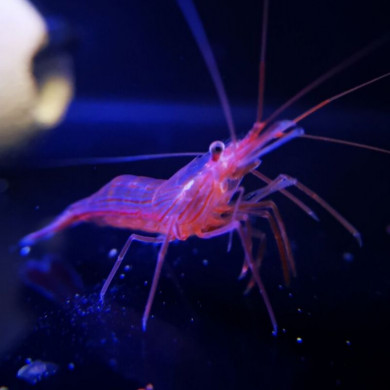3 ways to get rid of Aiptasia in reef tanks

Since the beginning of the reef hobby, Aiptasia count to the enemies of every aquarist. They belong to the sea anemones (Actiniaria) and are actually nice to look at. . . if it were not for their bad behavior towards other aquarium inhabitants.
In their tentacles, aiptasia have poisonous cells (cnidocytes), which they often use to nettle adjacent corals. Due to their ability to reproduce asexually from only a few cells, they can multiply rapidly within a short time and become a pest.
In the following we will show you three ways to quickly get rid of aiptasia in your tank!
#1 In case of light infestation: glue up aiptasia
If you spot single aiptasia in your aquarium, you can try to glue them up. For this you can either use a salt water resistant two-part epoxy or reef cement. After mixing the glue or cement you can apply the mass directly on the aiptasia and press it to the reef rock underneath.
The method of glueing is effective, but time-consuming and relatively expensive. Furthermore, it does not look very nice if your reef structure is covered with light-colored glue patches. Therefore, this method is only suitable in case of a light infestation with aiptasia to get the problem under control.
#2 The chemical way: injecting aiptasia
Another way to get rid of aiptasia in your tank is to inject them away with a syringe and a needle. For this purpose, different agents are used. You can either make them yourself or use ready-to-use products from various suppliers such as Elimi-Aiptas.
For instance, hydrochloric acid (33%) or caustic soda (32%) are suitable for combating aiptasia. You can get both solutions without any problems in the pharmacy. Please note that acids and alkaline solutions are highly aggressive. Therefore, always wear gloves and protective goggles. You should use a maximum of 5 ml of the acid or lye per 100 liters of aquarium water per day, otherwise the pH-value in your tank may change.
Another possibility is the use of calcium hydroxide (CaOH). However, this does not produce a liquid solution but a paste. For this you take about one tablespoon of the calcium hydroxide powder and mix it with some water.
The paste is then filled into the syringe, but this time you must not use a needle. Before adding the calcium hydroxide paste, it is recommended to turn off the flow pumps. Some of the mash is then applied to the mouth disk of the aiptasia from a short distance, whereupon the aiptasia begins to ingest the paste. A short time later it dissolves. It is recommended to siphon the dissolved aiptasia from your tank before turning on the flow pumps again.
Also here: Per day you should add a maximum of 5 ml of the paste per 100 liters of aquarium water.
#3 Biological weapons: Natural predators
Mother Nature has also come up with something for your fight against aiptasia. There are several predators, which prey on the anemones. Here are some recommendations:
- Berghia stephanieae
- Lysmata wurdemanni (Peppermint shrimp)
- Acreichthys tomentosus (Bristle-tail file fish)
Biological control of aiptasia: the Bristle-tail file fish can help
Biological control of aiptasia using predators is the only way to solve the problem in the long term. Of all three species mentioned here, aquacultured specimen are now available. Please inform yourself about the husbandry requirements of the respective animal before you buy.
B. stephanieae is a food specialist who only eats aiptasia. However, you need some of these animals in order to see their aiptasia-eating effect. It is recommended to use at least 5 to 10 animals per 300 liter aquarium volume.
Berghia snails are food specialists and feed only on aiptasia
Both peppermint shrimp and bristle-tail file fish can, under certain circumstances, attack corals and eat their polyps. For L. wurdemanni, a stocking of at least three animals per 100 liters of water volume is recommended. If possible, you should try not to feed the animals additionally. This increases the probability that they will feed on aiptasia. Even after the aiptasia have apparently disappeared completely, the animals should remain in the tank, as they usually do not eliminate the plague completely, but only keep it under control.
Lysmata shrimp eat aiptasia, but can also nibble on other corals
In addition, there are several species of emperor fish and butterfly fish that can be successfully used against aiptasia. Due to their size and their high space requirement, they are however not very suitable for keeping in a saltwater aquarium.
Aiptasia prophylaxis
To reduce the risk of an aiptasia pest from the outset, you can take various precautionary measures. On the one hand, examine every newly acquired rock and coral frag carefully. For example, if an aiptasia only sits on the edge of the frag plug, you can simply snap off the part with pliers. In addition, aiptasia reproduce particularly well if a lot of powdered food is added to the aquarium. If you have a problem with aiptasia, change your feeding to soluble or direct food.
Only the early bird catches the aiptasia!
After all, aiptasia can hardly be avoided in saltwater aquariums. Their ability to reproduce from a single cell ensures that they will sooner or later appear in any reef tank - no matter how thorough precautions are taken. Nevertheless there is no reason to panic. As soon as you discover the first aiptasia, react with one or more of the above mentioned countermeasures and the aiptasia, even if visible here and there, will hardly cause you any problems. The only important thing is that you react early.
.JPG)
.JPG)
.JPG)